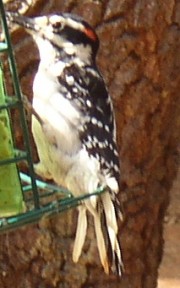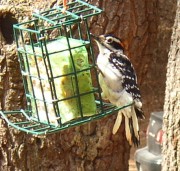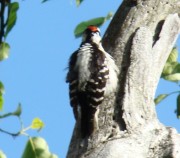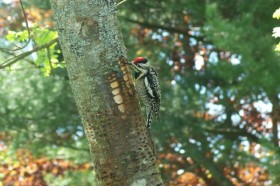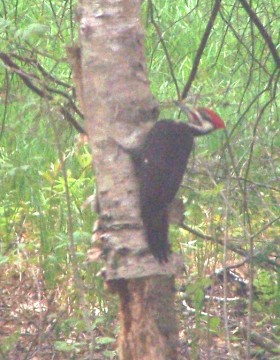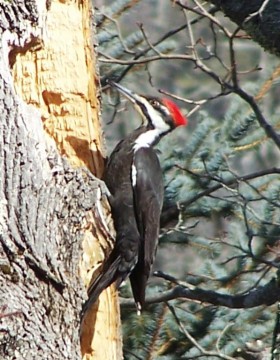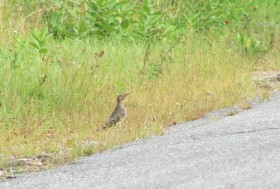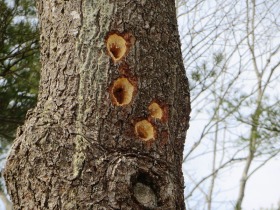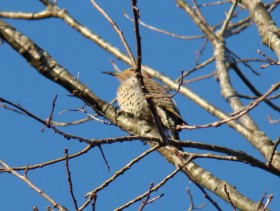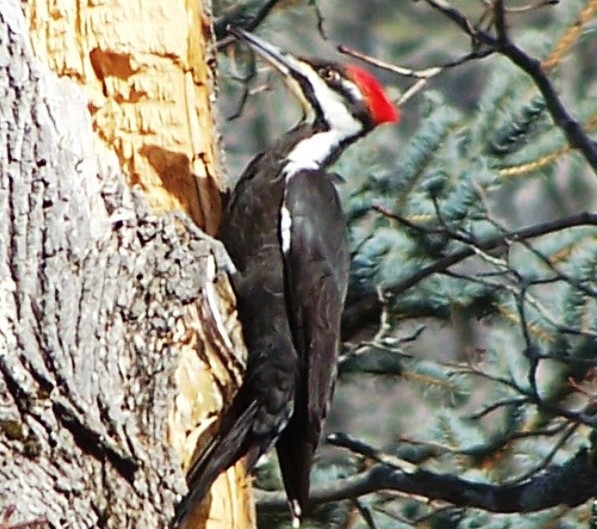
Maine Resident Woodpeckers
Four species of woodpeckers are among the birds that inhabit Maine. The essence of being a woodpecker is the use of its sharp, pointed bill for digging into trees for nesting and extracting insects.
Three share the title “woodpecker”: the Downy, Hairy, and Pileated. These three are year-round residents throughout the state and do not migrate. The Yellow-bellied Sapsucker and Northern Flicker are also woodpeckers.
Downy and Hairy Woodpeckers
The Downy is the smallest of the three at 6 inches and is similar in appearance to the 9 inch Hairy Woodpecker. The major distinction is the Downy’s shorter bill, size, and black spots on its tail. Both males have a red patch at the back of the head, a mark that is missing in their mates. Both consume seeds and insects, and come to suet feeders.
In the Audubon Field Guide*, the Downy’s habitat is listed as “Wood lots, parks and gardens; suet feeders in winter”; the Hairy’s habitat is listed as “Deciduous forest; more widespread in winter and migration.”
The bird on the right is probably the Hairy because of its size, the lack of identifiable black spots on its tail, and the fact that it was observed in July in a wooded rural area on a large dead branch.
Yellow-bellied Sapsucker
The female of this species, pictured here in Hampden, might be mistaken for a hairy woodpecker which is about the same size, but the Sapsucker’s red cap is larger. The male has a distinctive red throat and both have a white stripe on each wing and some pale yellow feathers of their breasts.
These woodpeckers drill neat rows of shallow holes, then lap up the sugary sap in the “sapwells,” along with any insects caught there. The photos of the female below were taken by David Ballard of Hampden.
Pileated Woodpecker
This woodpecker, at 19 inches, is more that three times as big as the Downy, and more than twice the size of the Hairy. It is probably responsible for the large (6-8 inches) holes below. These were found in Harpswell and Camden.
Northern Flicker
This 12 inch woodpecker is distinct from the others in several ways: it does not have the red, white, black color pattern; it feeds regularly on the ground looking for ants and beetles. This bird, found in Andover, creates round holes (cavities) as potential nesting sites. As do many Mainers, it migrates to the southern states in winter.
*Bull, John and John Farrand, Jr. The Audubon Society Field Guide to North American Birds: Eastern Region. New York: Knopf. 1977 and various years. p. 643.


